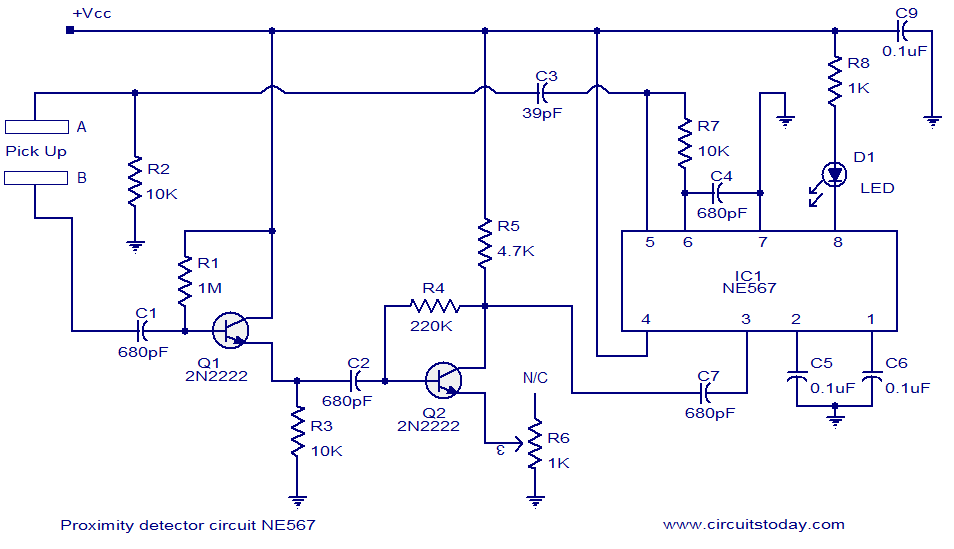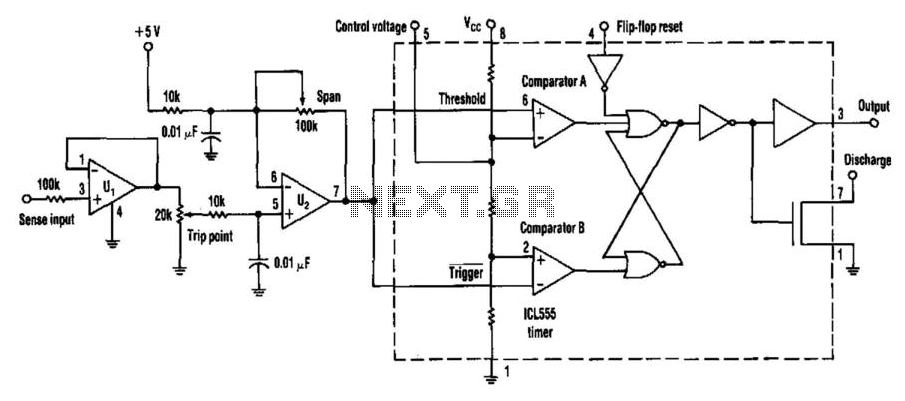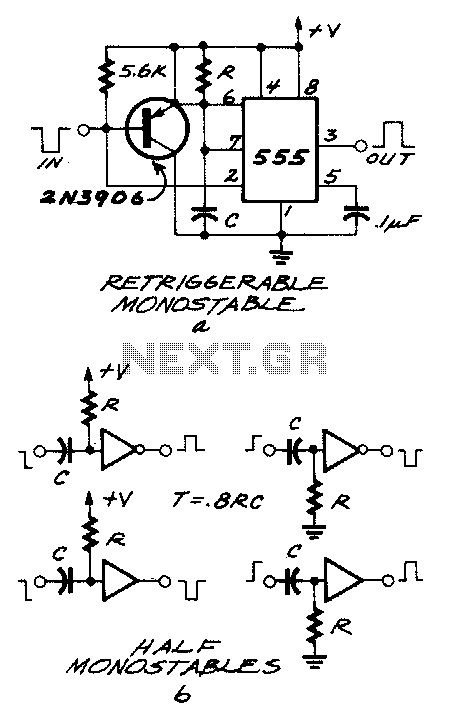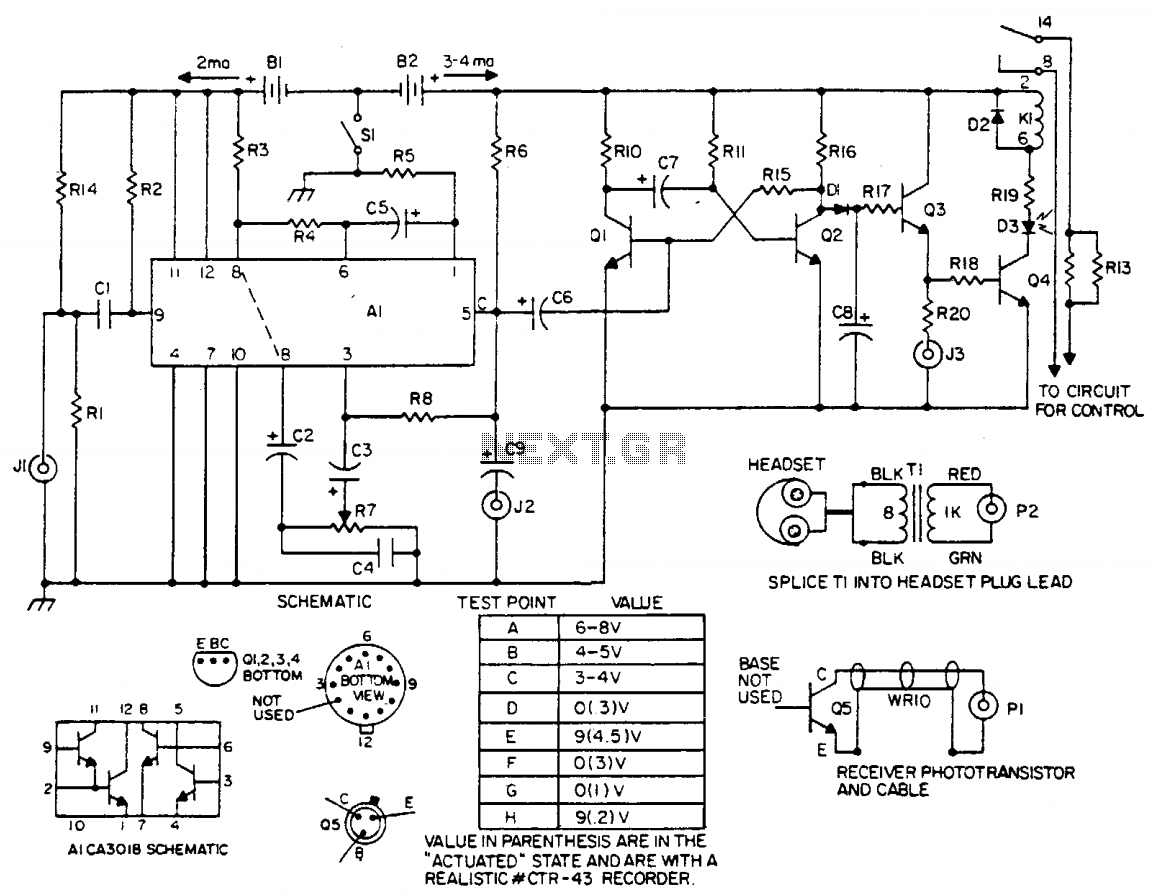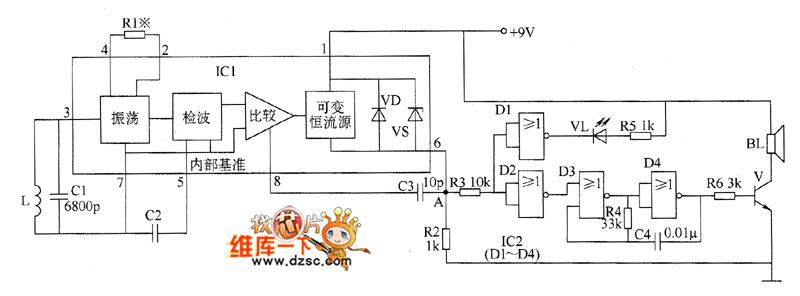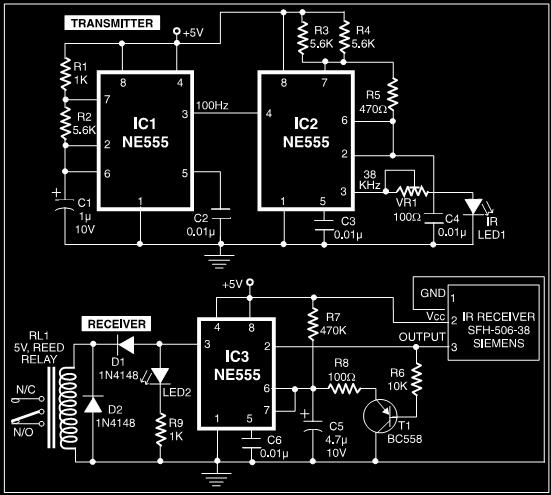
Metal detector 2
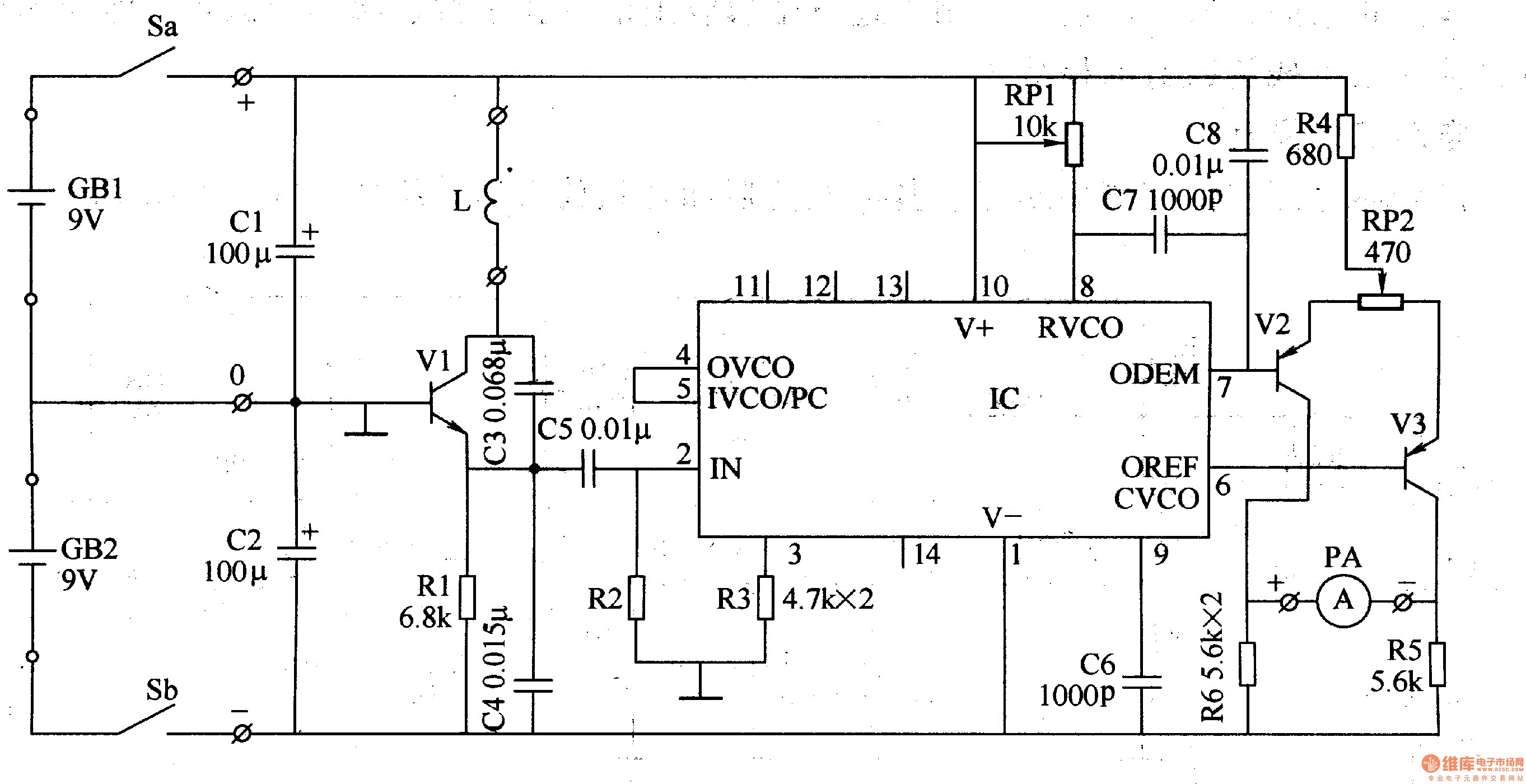
The metal detector described in the example can detect metal objects made of highly permeable magnetic substances. The circuit operates based on several components: a power circuit, a sine wave oscillator, a PLL (phase-locked loop) circuit, and a hybrid amplification circuit, as illustrated in Figure 8-68. The power circuit includes battery GBl, GB2, filter capacitors Cl and C2, and the power switch S (Sa, Sb). The sinusoidal oscillator circuit is formed by transistors Vl, a detecting coil L, capacitors C3-C5, and resistors Rl and R2. The PLL circuit consists of a dual time-base integrated circuit along with resistors R3, potentiometers RPl, and capacitors C6-C8. The hybrid amplification circuit includes transistors V2 and V3, resistors R4-R6, potentiometer RP2, and an ammeter PA. Resistors Rl-R6 are specified as 1/8W or 1/4W carbon film types. RPl is a multi-turn precision potentiometer, while RP2 is a general lap synthetic membranes potentiometer. Capacitors Cl and C2 are electrolytic with a voltage rating of 16V, C3-C5 and C8 are monolithic capacitors, and C6 and C7 are high-frequency ceramic capacitors.
The metal detector circuit is designed to efficiently identify metal objects by utilizing a combination of electronic components that work in unison. The power circuit is crucial for supplying the necessary voltage and current to the entire system, ensuring that all components operate effectively. The inclusion of filter capacitors (Cl and C2) helps to stabilize the power supply by reducing voltage fluctuations, which is essential for maintaining the performance of sensitive electronic circuits.
The sine wave oscillator circuit plays a pivotal role in generating the alternating current (AC) signal that is necessary for the operation of the detecting coil (L). This coil is responsible for creating a magnetic field that interacts with nearby metal objects. The oscillation frequency can be adjusted by changing the values of capacitors (C3-C5) and resistors (Rl and R2), allowing for fine-tuning of the detector's sensitivity and range.
The PLL circuit is essential for maintaining a consistent frequency and phase relationship between the transmitted and received signals. It utilizes a dual time-base integrated circuit, which helps in demodulating the signal received from the detecting coil. The resistors (R3) and potentiometers (RPl) in this circuit allow for precise adjustments to the loop characteristics, enhancing the detector's ability to differentiate between various types of metal.
The hybrid amplification circuit is designed to amplify the weak signals received from the detecting coil. This is achieved through the use of transistors (V2 and V3) and resistors (R4-R6), which boost the signal strength to a level that can be accurately measured by the ammeter (PA). The potentiometer (RP2) allows for further adjustment of the amplification level, providing the user with control over the sensitivity of the detector.
Overall, this metal detector circuit exemplifies a well-structured approach to metal detection, employing a range of electronic components that work together to achieve effective and reliable performance. The careful selection of resistors, capacitors, and other components ensures that the circuit operates within its intended parameters, making it suitable for various applications in metal detection.This metal detectors described in the example can be used to detect metal objects with high permeable magnetic substances. The working principle. The metal detector circuit is composed of the power circuit, sine wave oscillator, PLL phase-locked loop circuit and hybrid amplification circuit, it is shown in Figure 8-68.
Power circuit is composed of the battery GBl, GB2, filter capacitor Cl, C2, and the power switch S (Sa, Sb). Sinusoidal oscillator circuit consists of transistors Vl, detecting coil L, capacitor C3-C5 and resistors Rl, R2. PLL circuit is composed of dual time-base integrated circuit and resistors R3, potentiometers RPI, capacitors C6-C8.
The hybrid amplification circuit is composed of the transistors V2, V3, resistors R4-R6, potentiometer RP2 and ammeter PA. Rl-R6 use l/8W or 1/4W carbon film resistors. RPl uses multi-turn precision potentiometer; RP2 uses general lap synthetic membranes potentiometer. Cl and C2 select electrolytic capacitors with voltage in 16V; C3-C5 and C8 select monolithic capacitors; C6 and C7 select high-frequency ceramic capacitors.
🔗 External reference
The metal detector circuit is designed to efficiently identify metal objects by utilizing a combination of electronic components that work in unison. The power circuit is crucial for supplying the necessary voltage and current to the entire system, ensuring that all components operate effectively. The inclusion of filter capacitors (Cl and C2) helps to stabilize the power supply by reducing voltage fluctuations, which is essential for maintaining the performance of sensitive electronic circuits.
The sine wave oscillator circuit plays a pivotal role in generating the alternating current (AC) signal that is necessary for the operation of the detecting coil (L). This coil is responsible for creating a magnetic field that interacts with nearby metal objects. The oscillation frequency can be adjusted by changing the values of capacitors (C3-C5) and resistors (Rl and R2), allowing for fine-tuning of the detector's sensitivity and range.
The PLL circuit is essential for maintaining a consistent frequency and phase relationship between the transmitted and received signals. It utilizes a dual time-base integrated circuit, which helps in demodulating the signal received from the detecting coil. The resistors (R3) and potentiometers (RPl) in this circuit allow for precise adjustments to the loop characteristics, enhancing the detector's ability to differentiate between various types of metal.
The hybrid amplification circuit is designed to amplify the weak signals received from the detecting coil. This is achieved through the use of transistors (V2 and V3) and resistors (R4-R6), which boost the signal strength to a level that can be accurately measured by the ammeter (PA). The potentiometer (RP2) allows for further adjustment of the amplification level, providing the user with control over the sensitivity of the detector.
Overall, this metal detector circuit exemplifies a well-structured approach to metal detection, employing a range of electronic components that work together to achieve effective and reliable performance. The careful selection of resistors, capacitors, and other components ensures that the circuit operates within its intended parameters, making it suitable for various applications in metal detection.This metal detectors described in the example can be used to detect metal objects with high permeable magnetic substances. The working principle. The metal detector circuit is composed of the power circuit, sine wave oscillator, PLL phase-locked loop circuit and hybrid amplification circuit, it is shown in Figure 8-68.
Power circuit is composed of the battery GBl, GB2, filter capacitor Cl, C2, and the power switch S (Sa, Sb). Sinusoidal oscillator circuit consists of transistors Vl, detecting coil L, capacitor C3-C5 and resistors Rl, R2. PLL circuit is composed of dual time-base integrated circuit and resistors R3, potentiometers RPI, capacitors C6-C8.
The hybrid amplification circuit is composed of the transistors V2, V3, resistors R4-R6, potentiometer RP2 and ammeter PA. Rl-R6 use l/8W or 1/4W carbon film resistors. RPl uses multi-turn precision potentiometer; RP2 uses general lap synthetic membranes potentiometer. Cl and C2 select electrolytic capacitors with voltage in 16V; C3-C5 and C8 select monolithic capacitors; C6 and C7 select high-frequency ceramic capacitors.
🔗 External reference
